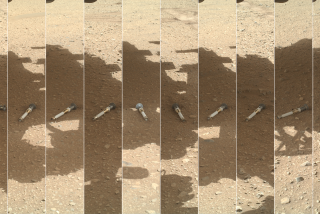Kicking the Tires on Mars
- Share via
There is a saying in robotics: You shouldn’t anthropomorphize robots. They don’t like it.
Even so, it’s hard not to think of the Mars Exploration Rover Spirit as a kind of gawky, geeky geologist moving in halting steps as it fitfully cogitates its path to the next interesting rock. All it needs is a pith helmet.
From my perspective as The Times’ auto reviewer, I can tell you there is nothing human at all about Spirit.
It’s a car.
Like any car, it has wheels. Yes, there are six of them, but a Ford “dualie” pickup has that many too. It’s underpowered (about 0.06 horsepower), but so are many vehicles from India.
With a top speed of about 0.1 mph, the brains of an obsolete desktop computer and the power of two light bulbs, the rover is not what you would call a space Ferrari.
But to the men and women of the Jet Propulsion Laboratory, it’s a screaming hot rod of interplanetary science.
“It’s an awesome machine,” said Spirit flight director Chris Lewicki. “It’s the coolest set of wheels on Mars.”
There are only two places in the universe to get behind the wheel of a rover. One is Pasadena, the other is Gusev Crater on Mars.
I opted for Pasadena, looking over the shoulder of rover operator Scott A. Maxwell at his keyboard cockpit as he rehearsed his first drives in the Martian countryside.
The rover is not a luxury vehicle. That’s a galactic understatement. There are no heated seats, no in-car DVD player, no tinted windows, no refrigerated glove box. You have to buy a Saab for that.
For a stripped-down model, it’s a bit on the expensive side -- about $410 million, with destination and delivery charges to Mars.
The first problem with driving the rover is that you can’t actually drive it. Mars is far away: 100 million miles, or 8.9 light-minutes. To send a message and get a reply takes, at best, about 20 minutes.
The delay means that Spirit, which rolled off its lander Thursday, cannot be “joysticked,” that is, controlled from the ground in real time. The Soviet Lunakhod moon rover -- a mere 3 light-seconds from Earth -- required a five-man team to tele-operate, and it was a handful.
“That time delay really messes us up,” said Brian Cooper, one of the rover controllers.
Spirit and its twin, Opportunity (scheduled to land on Mars on Saturday), are point-and-shoot machines. They are imbued with a large degree of autonomy, designed with their own decision-making software so that they may be at home on the Martian range.
What rover operators do is throw a lawn dart icon at a computerized map of Mars, marking the destination the science team back at JPL has picked out. Think of it as NASA’s version of the OnStar system.
Then, using its complex terrain visualization and guidance system, Spirit will traverse on its own to the target through a series of “way points.”
“We tell it: ‘You can get to this spot, and we don’t care how you get there and we don’t care what your final orientation is,’ ” Cooper said.
It’s kind of like driving a Hummer in Los Angeles.
The Hummer, at least, has headlights. The rover needs three sets of black-and-white navigational cameras to see where it’s going. One set of navigation cameras is on top of a mast, and two sets of hazard avoidance cameras are on its “bumpers.”
The three-dimensional images created are processed in two ways: human 3-D, the kind of stereoscopic images familiar from cheesy horror movies; and machine 3-D, a swarming cloud of data points that model the contours of the terrain.
The human 3-D images are fed into special LCD goggles -- high-tech versions of those “Night of the Living Dead” specs -- that help drivers visualize hazards on the surface.
“It looks like you are walking on Mars,” Cooper said.
Maybe, but in the dim control rooms of JPL, the rover drivers in their dark shades look like jazz musicians grooving on a cosmic melody.
But even the most data-rich terrain map can be treacherously incomplete because Spirit cannot see behind rocks and obstacles. It’s like driving through the desert at night. The long shadows cast by rocks and brush are analogous to the hollows of incomplete data.
“The problem is that neither the rover nor the human planners on Earth can see very far away,” said Mark Maimone, a space robotics expert at JPL. “It sees pretty well 10 to 20 meters out, but it falls off after that.”
As a result, it’s easy for the rover -- and its backseat drivers at JPL -- to get disoriented, as if it were navigating an unfamiliar city at night.
To keep track of its position, Spirit is equipped with an inertial measurement unit, the same hardware that helps tell an F-16 pilot which way is up.
“It’s really quite challenging in the Mars-like terrain to keep a good idea of your position and which way you’re pointed,” Maimone said.
So let me get this straight: You can’t really drive it. You can’t really see out of it. It’s overpriced. It’s like driving a Lincoln Town Car.
Now that Spirit has rolled onto the surface, the engineers and scientists are eager to put the pedal to the metal.
“The overwhelming feeling on the engineering team is, ‘Gun it,’ ” Lewicki said.
Yet even at full throttle, Spirit accelerates like a Vespa scooter dragging a mailbox.
Spirit is powered -- if that’s not too much of a misnomer -- by six DC motors, about the size of C batteries, situated inside the wheels. If controllers were indeed to “gun it,” the motors’ total output would be about 0.06 horsepower.
Spirit doesn’t accelerate so much as stagger toward its horizon. Its hazard-avoidance software allows the vehicle to move forward anywhere from an inch to a yard at a time. Then the rover stops, takes more pictures, considers the best direction to go, takes another step and repeats the process.
So while the rover’s maximum speed is about 600 feet an hour, with the hazard-avoidance system driving Miss Daisy, the pace is a more leisurely 120 feet an hour.
“The main thing is we don’t want the vehicle to get stuck on a rock, to get high-centered,” said Maimone, who wrote the obstacle-avoidance software. “We want to be conservative.”
The one place where the rover really shines is off-road -- really, really off-road.
Land Rover Defender 90? Toyota Land Crusher? U.S. Army Recon HUMVEE with optional TOW missile launcher? Wimps.
The fuselage of the vehicle -- called the Warm Electronics Box because it provides the temperature-controlled environment for the batteries and instruments -- is double-walled with panels of alloy honeycomb and epoxy graphite laminate, materials that wouldn’t be out of place on a Formula One car.
Between the walls is an insulating foam called Aerogel. An array of batteries, heaters and plutonium-powered heater units keeps the interior temperature a toasty minus 4 degrees Fahrenheit and above.
When you look at the rover (a working version resides in the testing labs at JPL) you can’t help but marvel at its utter lack of styling. As I stand there studying it, images of a titanium Ninja dodo bird form in my mind.
The wheels’ spiral design (shades of the old ZR-1 Corvette) acts as a spring, giving Spirit enough flexibility to withstand a drop from nearly a foot onto a hard surface. The black coating on the outside of the wheels is anodized aluminum, not rubber.
But the thing that really gives it off-road chops is its “rocker-bogie” suspension, aluminum and titanium linkages that support the vehicle on its six bowl-shaped aluminum wheels. The rockers can articulate as much as 30 degrees.
To help keep the vehicle level, a geared differential connects the left and right sets of wheels so they act in opposition: When one set of wheels goes up, the other goes down, effectively halving the vehicle’s tilt.
If the rover’s suite of accelerometers and laser gyroscopes detect the vehicle tilting at more than 30 degrees, it will order Spirit to stop (although its tip-over point is more like 45 degrees).
Even though it’s short on horsepower, it’s way long on torque.
It’s tractor-like gear ratio allows it to climb over 15-inch rocks, 1 1/2 times the height of the wheels. It would be like a Hummer parking on a Lamborghini.
“I wish I could take this thing out to the canyons and go rock climbing with it,” said Don Bickler, the engineer who created the rocker-bogie system. “This sucker will climb a wall.”
And with its four-wheel independent steering, Spirit brings new meaning to the words parallel park, able to crab sideways into a parking space just 5 1/2 feet wide.
And if you get in a jam, just pick it up. Spirit’s curb weight is 384 pounds on Earth, but only 184 pounds on Mars.
All in all, the 2004 Mars Exploration Rover Spirit, I’ve decided, is a decent enough interplanetary sport utility vehicle that makes up in ability what it lacks in curb appeal.
As I drove away from the JPL campus in a borrowed GMC Envoy XUV behemoth, I was already missing Spirit’s geeky innocence and pluck. Oh, there I go anthropomorphizing it.
It’s a car.
Like all cars, Spirit will eventually break down. Currently it’s late summer on Mars; that gives the solar-powered rover about a four-hour workday, when its 14 square feet of solar panels are generating about 140 watts, give or take a shadow.
As the Martian summer turns to fall, and dust collects on Spirit’s solar panels, the rover will have less and less power.
One day Spirit won’t start at all. And there’s no AAA on Mars.






